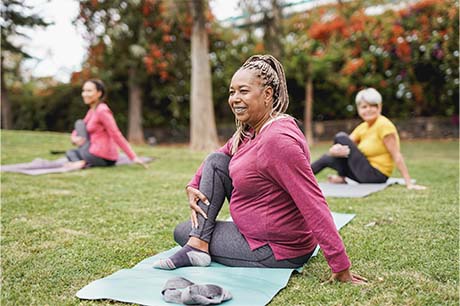Exercise tips to get fit, safely
Meet your workout goals — without getting injured
Maybe your job and kids and countless commitments have kept you from the gym lately.
Or you’ve been sidelined by an injury.
Or maybe you’ve never exercised at all — but you’re ready to get started.
The important thing is, you’re now committed to getting moving, whether that means picking up an old routine or trying a new form of exercise.
Good for you — literally. Especially if you’re trying something new. “Teaching your body new skills promotes good health and keeps your coordination sharp,” says Dr. John Lynott, orthopaedic surgeon at Geisinger.
Just make sure you understand your body’s limits and train wisely, whether your goal is to cross the finish line at a charity fun run — or take that dream bike tour through Europe.
Listen to your body’s limits and always warm up
Before beginning any new exercise routine, make sure you’re healthy enough for physical activity. This could mean going for a short hike to see how you feel afterward or taking a quick trip to the doctor’s office for a physical.
“You should always be aware of your limitations — and remember that we all have them,” says Dr. Lynott. “If you have a history of heart problems or injuries, consider getting a checkup before ramping up your physical activity.”
You can also maintain good health by remembering to warm up before each workout, stretch afterward and stay hydrated all day long.
Start small and build toward larger fitness goals
Tying your goal to a specific race or milestone is a great way to stay focused and build a timeline. But starting small and working toward your goal will help you avoid injuries and burnout. Increase the distance of your hike, run or bike ride at a slow pace and leave plenty of time to recover in between.
“The impact of exercise could cause inflammation in your muscles and joints, especially if you’ve had injuries in the past or just haven’t done much physical activity,” says Dr. Lynott. “Remember to listen to your body and rest when you need to.”
Be aware of any changes or pain in your body and rest if you have pain. And give your doctor a call if you notice anything new that lasts more than a day.
Diversify your workout routine
Keep your day-to-day workouts interesting. One-dimensional, cardio-focused routines can mean slow progress and an increased risk of injury.
“Strengthening one muscle group without supporting others leaves you with uneven strength and flexibility,” says Dr. Lynott. “That might cause you to strain the other muscles and joints without even knowing it.”
Plus, mixing other exercises into your routine can lead to better performance in your favorite sport or form of cardio. So, consider practicing your primary sport or form of cardio three days per week. Work in different types of workouts, like weight training or restorative yoga, two to three days a week. And always make time for a rest day, which can still include light activities such as walking or stretching.
With these tips, you’ll be well on your way to safely meeting your exercise goals.
Next steps:
Meet Dr. John A. Lynott, MD
Watch: How to start exercising
Weekend warrior? Warm up like a RailRider.





